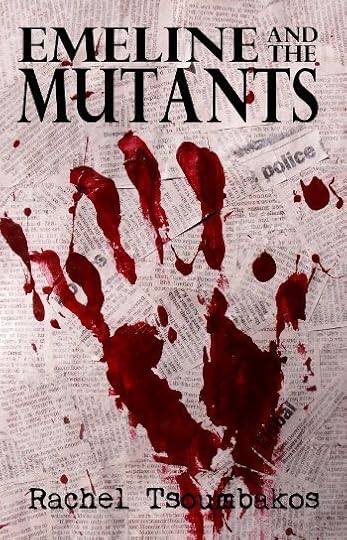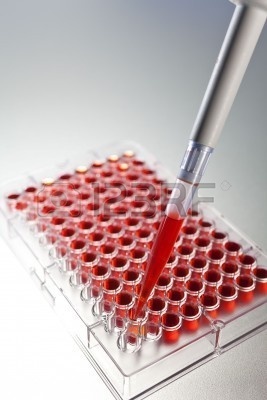Creating a Zombie Cover: Guest Post by Rachel Tsoumbakos
This post is by Rachel Tsoumbakos, the author of Emeline and the Mutants, and The Ring of Lost Souls. It originally appeared on the Cabin Goddess blog as part of Zombie week.

My kids are eleven and eight. For them, a normal day is to come home and find their own mother elbow deep in blood splatters. Such is the woes when mum is an author of the post-apocalyptic zombie novel, Emeline and the Mutants (insert Amazon link here). Sometimes their input is endearing: "Mummy, that's looks great!" Other times disturbing: "Can I have a go at smearing the blood?" But, all in all, it is something they no longer bat an eyelid at. Rachel, in a non-bloody moment
Rachel, in a non-bloody moment
So, how does one go about creating a bloody cover for a book? It sounds simple enough. Red paint + handprint = cover. Right? No, wrong. The bloody handprint wasn't the first idea. It wasn't even the first cover Emeline and the Mutants ever wore.
The very first cover involved blood spatter too, but it wasn't my own, so it had to go. Now being the handy (excuse the pun) sort of person I am, I decided cover art is something I could do. And certainly, I did produce a cover, but it was a long hard journey for a novice.
First, blood red is not a colour my local art supplies store stocked. You'd think it was a common shade of red, but according to the creeped-out look on the assistant's face, it's not. Instead I bought several tubes of paint in an attempt to mix my own. The first batch was pretty good too- until it dried. It went from shiny, vibrant, life-giving red to a darker shade of Uluru in about three hours.
This led me to the conclusion that I needed to photograph as I went or find another way to make the red stay the right colour. I decided to take photos, but first I had to property design the background newsprint. Is it just me or does everyone who is cutting and pasting newspaper look over their shoulder constantly and feel the need to have a hostage to complete the task? It's probably just me, yeah? Thought so.
So, with the background suitably newspapery, it was time to start with the blood. I mixed up my blood red and painted my hand. With it poised and really above my masterpiece, I suddenly had the brilliant idea to add PVA glue to the paint. Perhaps this would make it shinier. Not to mention more globular when I started the splattering phase of my artwork.
Do you have any idea how hard it is to wash acrylic paint off your hand? Neither did I. Having to explain 'blood' under my fingernails at school pick-up was a real challenge also. With a (mostly) cleaned hand, I added the glue. Then some more red followed by a smidge more black paint since the PVA lightened the colour quite significantly. But it was an instant improvement. Not only did the paint take longer to dry and stayed shinier and lighter, but it didn't dry on my hand as quickly.
Take two of my bloody handprint turned out to be a great success, or so I thought. The image was clear on the paper and the colour was fantastic. One look at it by my critics (read: my children) and the general announcement was that it was boring. Boring? How could a bloody mess on a piece of paper be mundane? I quizzed my kids further. Turns out, they just wanted to see more blood and a smearier image. Once again, I wasn't sure if I should be proud or disturbed at their comments.There is much fun to be had in blood spattering, let me tell you. Not only do you have to don old clothes, but you need to cover your entire dining room with newspaper. You may be planning to hit just one small piece of artwork with paint, but the reality is that even the roof is within firing line!Now, it seems to take a certain amount of maniacal glee to create the right spattering effect in blood. Light flicking aimed at the exact spot you expect it to land results in nothing more than a pinprick or two of colour and one big ugly blob. The trick is to really get your arm back over your head and fling your implement (in my case an old chopstick) like you are intending to cause injury. This level of intensity creates a splatter pattern akin to repeatedly stabbing someone you no longer like. Great viscous strands of bloody carnage result, the likes of which you can see in the image of my current book cover of Emeline and the Mutants.
[image error] Rachel Tsoumbakos is a stay home mother of two. Her main passions are writing, reading and organic gardening. Rachel lives with her husband, two kids, three cats and seven chickens in suburban Melbourne, Australia. While she has had several articles published through mainstream magazines, she has also written extensively for Suite 101 and True Blood Net.

My kids are eleven and eight. For them, a normal day is to come home and find their own mother elbow deep in blood splatters. Such is the woes when mum is an author of the post-apocalyptic zombie novel, Emeline and the Mutants (insert Amazon link here). Sometimes their input is endearing: "Mummy, that's looks great!" Other times disturbing: "Can I have a go at smearing the blood?" But, all in all, it is something they no longer bat an eyelid at.
 Rachel, in a non-bloody moment
Rachel, in a non-bloody momentSo, how does one go about creating a bloody cover for a book? It sounds simple enough. Red paint + handprint = cover. Right? No, wrong. The bloody handprint wasn't the first idea. It wasn't even the first cover Emeline and the Mutants ever wore.
The very first cover involved blood spatter too, but it wasn't my own, so it had to go. Now being the handy (excuse the pun) sort of person I am, I decided cover art is something I could do. And certainly, I did produce a cover, but it was a long hard journey for a novice.
First, blood red is not a colour my local art supplies store stocked. You'd think it was a common shade of red, but according to the creeped-out look on the assistant's face, it's not. Instead I bought several tubes of paint in an attempt to mix my own. The first batch was pretty good too- until it dried. It went from shiny, vibrant, life-giving red to a darker shade of Uluru in about three hours.

This led me to the conclusion that I needed to photograph as I went or find another way to make the red stay the right colour. I decided to take photos, but first I had to property design the background newsprint. Is it just me or does everyone who is cutting and pasting newspaper look over their shoulder constantly and feel the need to have a hostage to complete the task? It's probably just me, yeah? Thought so.
So, with the background suitably newspapery, it was time to start with the blood. I mixed up my blood red and painted my hand. With it poised and really above my masterpiece, I suddenly had the brilliant idea to add PVA glue to the paint. Perhaps this would make it shinier. Not to mention more globular when I started the splattering phase of my artwork.
Do you have any idea how hard it is to wash acrylic paint off your hand? Neither did I. Having to explain 'blood' under my fingernails at school pick-up was a real challenge also. With a (mostly) cleaned hand, I added the glue. Then some more red followed by a smidge more black paint since the PVA lightened the colour quite significantly. But it was an instant improvement. Not only did the paint take longer to dry and stayed shinier and lighter, but it didn't dry on my hand as quickly.

Take two of my bloody handprint turned out to be a great success, or so I thought. The image was clear on the paper and the colour was fantastic. One look at it by my critics (read: my children) and the general announcement was that it was boring. Boring? How could a bloody mess on a piece of paper be mundane? I quizzed my kids further. Turns out, they just wanted to see more blood and a smearier image. Once again, I wasn't sure if I should be proud or disturbed at their comments.There is much fun to be had in blood spattering, let me tell you. Not only do you have to don old clothes, but you need to cover your entire dining room with newspaper. You may be planning to hit just one small piece of artwork with paint, but the reality is that even the roof is within firing line!Now, it seems to take a certain amount of maniacal glee to create the right spattering effect in blood. Light flicking aimed at the exact spot you expect it to land results in nothing more than a pinprick or two of colour and one big ugly blob. The trick is to really get your arm back over your head and fling your implement (in my case an old chopstick) like you are intending to cause injury. This level of intensity creates a splatter pattern akin to repeatedly stabbing someone you no longer like. Great viscous strands of bloody carnage result, the likes of which you can see in the image of my current book cover of Emeline and the Mutants.
[image error] Rachel Tsoumbakos is a stay home mother of two. Her main passions are writing, reading and organic gardening. Rachel lives with her husband, two kids, three cats and seven chickens in suburban Melbourne, Australia. While she has had several articles published through mainstream magazines, she has also written extensively for Suite 101 and True Blood Net.
Published on June 14, 2012 06:00
No comments have been added yet.



